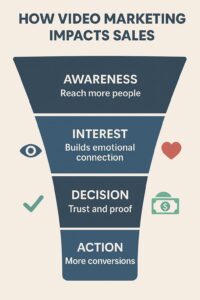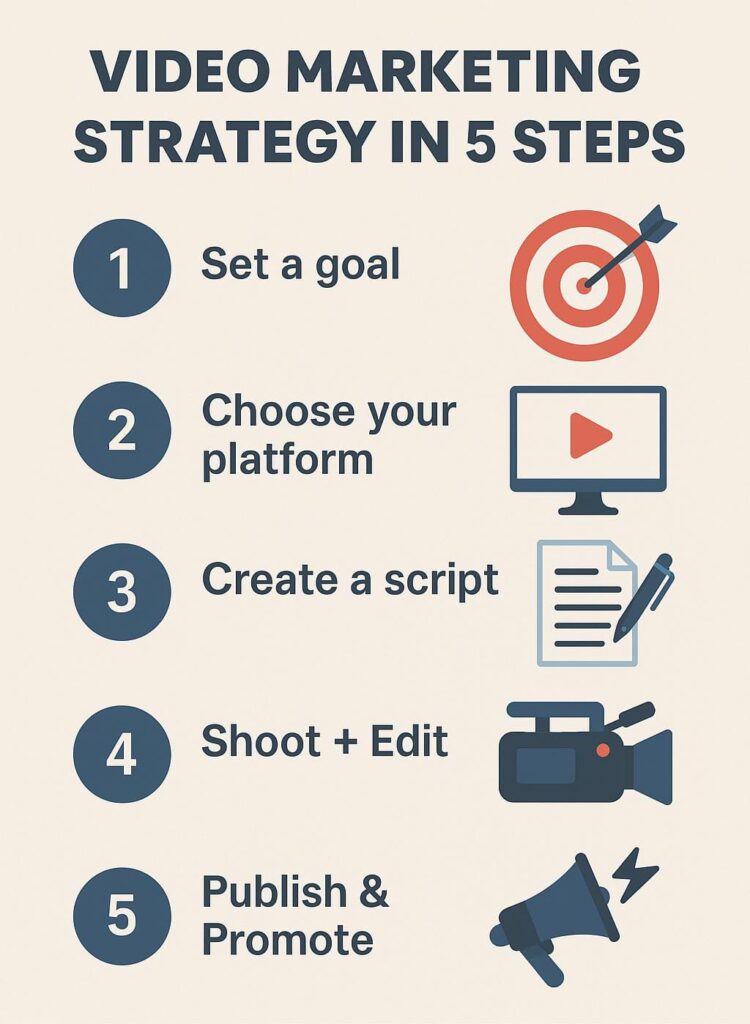Video Marketing is one of the most powerful tools in digital marketing today. Whether you’re a brand, a business, or a personal creator, using videos to reach your audience can build trust, increase engagement, and boost your sales. This blog will walk you through everything you need to know about video marketing, its benefits, strategies, and how you can get started—even as a beginner.
What is Video Marketing?
Video marketing means promoting a product, service, or idea using videos. These videos can be posted on platforms like YouTube, Instagram, Facebook, LinkedIn, or even embedded on websites and emails. It allows businesses to showcase their message in an entertaining, visual, and easy-to-understand format.
Why is Video Marketing Important?
In today’s digital world, people prefer watching videos over reading long texts. Videos are more engaging, easier to remember, and they help brands connect emotionally with the audience.
Here’s why video marketing is crucial:
- People retain 95% of a message when they watch it in a video compared to 10% when reading it in text.
- Videos can increase conversion rates on landing pages by up to 80%.
- Platforms like YouTube and Instagram are constantly growing, meaning video content reaches more people.
Types of Video Marketing Content
There are different kinds of videos you can create depending on your goals:
1. Explainer Videos – To educate the audience about your product or service.
2. Product Demos – To showcase how your product works.
3. Testimonials – Real customers sharing their experiences.
4. Behind-the-Scenes – Gives a personal touch to your brand.
5. Live Videos – For Q&As, product launches, or events.
6. Short-form Content – Instagram Reels, YouTube Shorts, etc., are ideal for quick engagement.
How Video Marketing Impacts Sales
Understanding how video fits into the customer journey can help you design better campaigns.
Here’s how video marketing impacts each sales stage:

- Awareness – Reaches a larger audience and introduces them to your brand.
- Interest – Builds emotional connection and keeps viewers engaged.
- Decision – Offers proof and trust through reviews, tutorials, or detailed demos.
- Action – Increases conversions through clear CTAs (Call-To-Actions).
This funnel-style approach works best when you tailor video content for each stage.
Platforms for Video Marketing
Choosing the right platform depends on your audience:
- YouTube – Best for educational and long-form content.
- Instagram & Facebook – Great for short, eye-catching videos.
- LinkedIn – Perfect for professional audiences.
- Your Website – Product demos and testimonials can help improve conversion rates.
Benefits of Video Marketing
Let’s look at some key advantages of using videos in your marketing strategy:
1. Higher Engagement – Videos grab attention quickly.
2. Better SEO – Websites with videos rank higher in Google search results.
3. More Conversions – Videos can explain benefits clearly, helping buyers make decisions.
4. Builds Trust – People connect better with real faces and voices than with text.
5. Social Sharing – Videos are more likely to be shared on social platforms.
Common Tools for Video Marketing
You don’t need fancy equipment to get started. Here are some beginner-friendly tools:
-
- Canva & InVideo – For creating animated and social media videos.
- CapCut & VN Editor – Mobile editing apps for Instagram Reels and YouTube Shorts.
- OBS Studio or StreamYard – Great for live streaming.
- Loom – Screen recording for tutorials or walkthroughs.
Most tools have free versions that you can experiment with.
Beginner Tips to Start Video Marketing
If you’re new to video marketing, don’t overthink it. Here’s how to begin:
1. Define your goal – Is it awareness, engagement, or sales?
2. Choose the right platform – Where is your target audience most active?
3. Start simple – Use your phone to record basic videos and learn editing gradually.
4. Add subtitles – Many people watch videos without sound.
5. Be consistent – Regular posting builds familiarity with your audience.
Future Trends in Video Marketing
As technology evolves, video marketing is also changing. Understanding these trends can help you stay ahead:
AI-Generated Videos –
Tools like Synthesia can create talking avatars to explain services.
Interactive Videos –
Videos where users click to choose what happens next are growing in e-learning and product demos.
360° and Virtual Reality –
Brands are using immersive videos to give virtual tours of products or stores.
Shoppable Videos –
Especially on platforms like Instagram, you can now directly purchase through the video.
User-Generated Content (UGC) –
Encouraging customers to create videos about your product adds social proof.
These trends show that video is not just a current strategy, but the future of content marketing.
Final Thoughts
Video marketing is not just a trend—it’s a necessity. Whether you’re a small business owner, student, or content creator, videos offer an incredible way to grow your online presence. With easy-to-use tools and platforms, anyone can get started—even without experience.
If you focus on your message, stay consistent, and keep improving your content, video marketing can truly transform your online journey.
Written by Priyanshi Jain
Delhi, India | digitalpriyanshi.com
